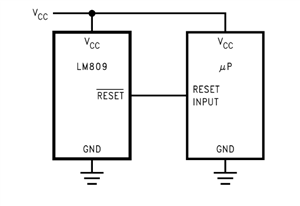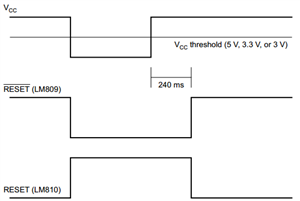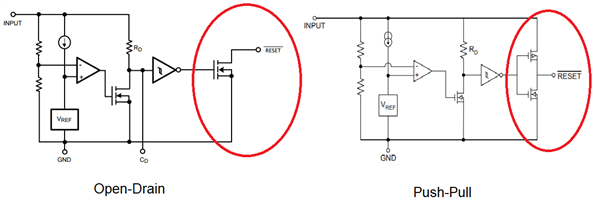SSZTAR7 october 2016 LM809 , LM810
Power-supply voltages in telecom, industrial and avionics applications can vary for many reasons, such as line and load transients; power outages; or a low battery. Voltage detectors and supervisors/reset integrated circuits (ICs) provide an early indication of supply-voltage deviations related to these issues to help protect the system.
Although voltage detectors and supervisors/reset ICs have the same functionality, they are used in different types of systems. A voltage detector monitors a voltage (like a battery voltage) and indicates to users that the voltage is low. Voltage detectors usually don’t have a delay, but they do have built-in hysteresis to prevent false triggers if the voltage is hovering around the threshold voltage.
A supervisor/reset IC monitors a supply voltage and resets or turns off another device like a microprocessor if the supply voltage is low. These devices usually have a programmable output delay to prevent the system from returning from reset before the supply voltage is stable.
Voltage detectors and supervisors/reset ICs have different features and parameters, making it tough to choose the right one for a given application. The key to choosing a voltage supervisor is to know the features you need and then select one based on your desired size, package type and price. In the first installment of this two-part series, I will discuss the simplest voltage detectors and some different output options. In the second installment, I’ll cover advanced monitoring and various features in voltage detectors and supervisors.
The Simplest Way to Monitor Voltage
 Figure 1 LM809 Typical Application Circuit
Figure 1 LM809 Typical Application CircuitWhen the supply voltage at VCC drops below the LM809’s reset threshold, the reset pin drops low and triggers the microprocessor to reset.
Output Type: Active Low vs. Active High, Push-pull vs. Open Drain
 Figure 2 Active Low (LM809) vs. Active High (LM810)
Figure 2 Active Low (LM809) vs. Active High (LM810)Push-pull and open drain refer to an output type. Push-pull uses two transistors at the output, with the top transistor turning on to set the output high and the bottom transistor turning on to set the output low. Open drain uses one transistor to set the output low and a pull-up resistor instead of a top transistor to set the output high. The advantage of push-pull is speed and lower power consumption. Open-drain outputs, however, can be wired together to create an OR/AND logic output configuration. Figure 3 illustrates both open-drain and push-pull outputs.
 Figure 3 Output Types
Figure 3 Output TypesNow that I’ve covered the basics of voltage detectors and supervisors/reset ICs, see part 2 to learn about the various features and more complex ways to monitor voltage.